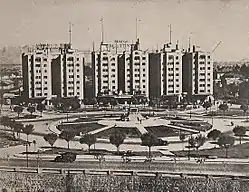Plaza Baquedano
Plaza Baquedano is a major landmark in Santiago, Chile.


The plaza was inaugurated in 1928, being crowned by a monument made by Chilean sculptor Virgínio Arias and featuring General Manuel Baquedano, giving the current name to the urban landmark. It is located where formerly the Mapocho River used to fork. The oval-shaped plaza is the focal point of celebrations and riots in the city. The area also serves as a hub for Santiago's street network. Some of the main streets of Santiago intersect in the area, including Providencia Avenue, Libertador General Bernardo O'Higgins Avenue (best known as Alameda) and Vicuña Mackenna Avenue. A tunnel entrance to the Costanera Norte Highway is close to Plaza Baquedano. Parque Forestal, Balmaceda Park and Bustamante Park converge here.
History
It was established in 1875 as Plaza La Serena and adopted its current name in 1928 to honor Manuel Baquedano.[1] It was originally a traffic circle but its geometric design and functionality have changed since then.
Baquedano metro station is named after Plaza Baquedano.
In the context of the 2019 protests, the protesters have dubbed the square as Plaza Dignidad or Plaza de la Dignidad (Dignity Square).[2] At least two people have died in the square during days of protest. [3] [4]
References
- "A la inauguración del monumento al General Baquedano asistieron S. E. y Ministros de Estado" (PDF). La Nación (in Spanish). 19 September 1928.
- "Chile and a global revolution for dignity". OpenGlobalRights. Retrieved 5 July 2020.
- "Abel Acuña's death". euronews.com. Retrieved 5 July 2020.
- "SML afirma que causa de muerte de Mauricio Fredes fue asfixia por sumersión". elmostrador.cl. 30 December 2019. Retrieved 5 July 2020.
| Wikimedia Commons has media related to Plaza Baquedano. |
